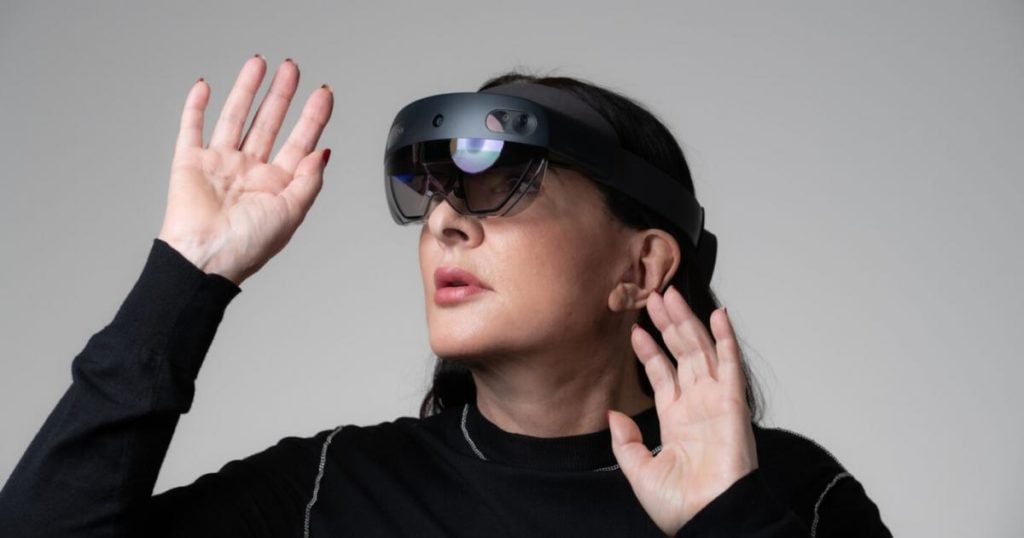Last week, amid all the other chaos in the world, something startling happened: a Microsoft promo for the HoloLens 2 mixed-reality headset featuring performance artist Marina Abramović ignited a backlash so fierce that the Seattle software giant evidently took it offline (the company itself isn’t offering comment). I set out to trace the origin of the backlash. What I found is that, as they say, this rabbit hole goes deeper than I expected.
The immediate cause of the Microsoft flame-up appears to be a blog post on Alex Jones’s Infowars site. On his broadcast, Jones referred to the HoloLens spot as “a two-and-a-half minute ad literally worshipping the head of the Church of Aleister Crowley,” referring to Abramović.
In any case, I find that the original Infowars post itself cites another source for authority: Out of Shadows, a one-hour-and-17-minute YouTube documentary featuring two former Hollywood stuntmen talking about their beliefs that a Satanic plot has infested the entertainment industry. That film reserves a special place in its climax for Marina Abramović as the puppet-mistress behind it all.
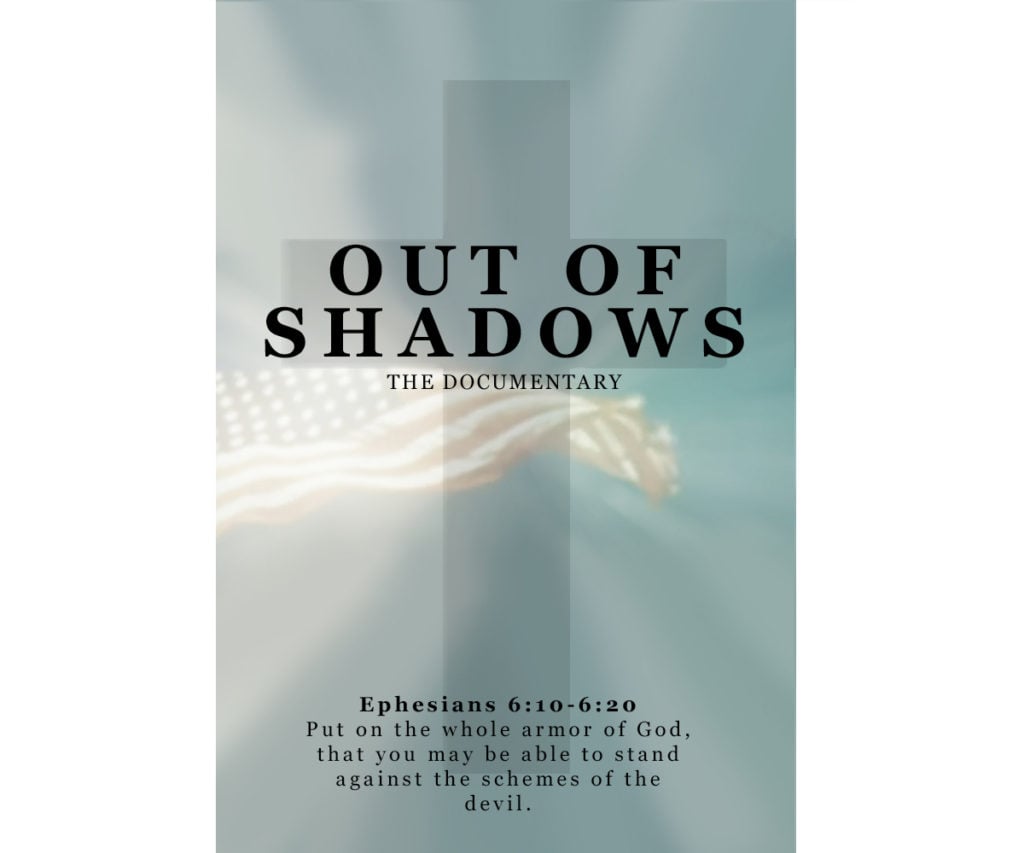
Cover graphic for Out of Shadows (2020).
Before I continue, I want to lay out a simple formula: I think you should not write about a fringe internet conspiracy theory if the number of people talking about it is smaller than the number of people who are likely to read what you write.
But more than 9 million people have watched one YouTube version of Out of Shadows since it was posted online just one week ago, with a couple million more watching various mirrored versions. For comparison, Abramović’s own 2015 TED talk has accumulated 2.7 million views. The New York Times‘s “TimesTalks” interview with the artist has been seen about 400,000 times. Art21, the PBS show, has a 2012 clip about Abramović’s love of fashion that has 250,000 views.
Conspiracy videos are, in effect, a major avenue by which the popular image of art is being shaped. Their ripple effects are likely to extend far beyond a Microsoft commercial.
Hiding in the Shadows
I won’t summarize all of Out of Shadows here, but I will offer a sense of what it has to say.
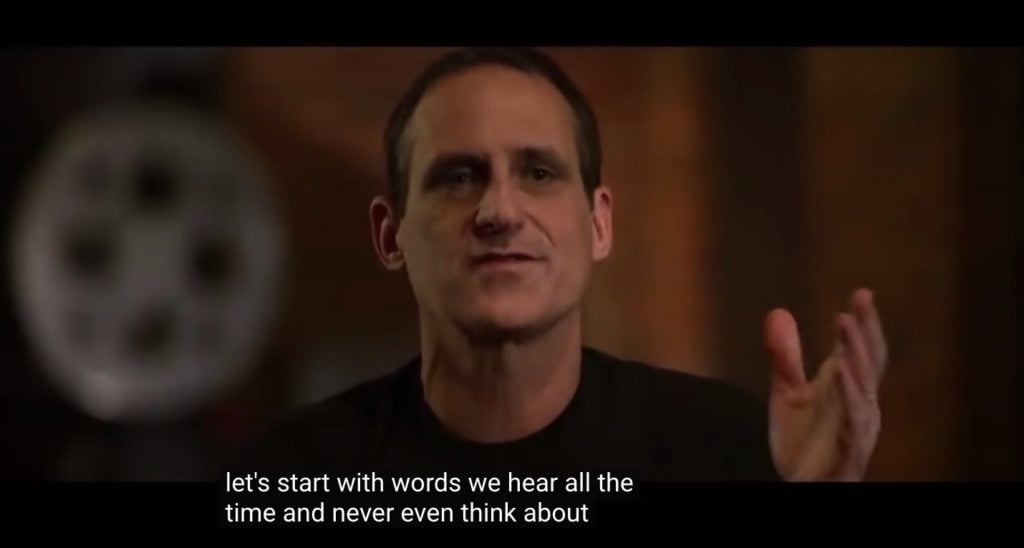
Screenshot of Mike Smith in Out of Shadows.
First, you are introduced to earnest, likable former Hollywood stuntman Mike Smith, who, after a tragic on-set accident in 2015, meets a physical therapist who opens his eyes to the “spirit world,” helps him find his faith, and makes him aware of the “Satanic people” controlling the film industry. Out of Shadows then follows his account of being converted by truth-seeking blogs, articles, and videos online and discovering the “very small group of people who influence all the content we watch.”
You’d think that the point of centering the video on someone like Smith would be his firsthand testimony of evil doings behind the scenes in Hollywood. Not really. “I’ve seen things at parties,” is all he says. “I’ve seen artwork, I’ve seen statues, I’ve seen things in some people’s houses that seem to be mimicking occult stuff I’m reading about. So I’m just like, maybe there is something to this.”
The “stuff he’s reading” is much more important than anything he’s actually seen, and most of Out of Shadows simply uses his narrative as a takeoff point for explicating a variety of theories about an alliance among government, media, and the occult.
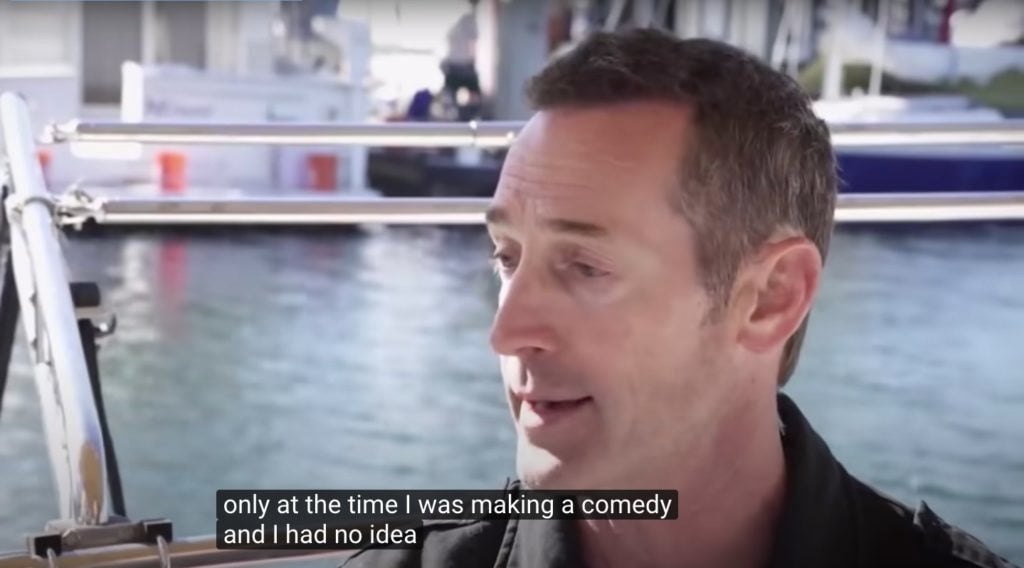
Screenshot of Brad Martin in Out of Shadows.
In this, Smith is joined by another stuntman, former George Clooney double Brad Martin. At about the half-hour mark, Martin explains how he came to realize that Zoolander, a film he worked on, is actually covert CIA propaganda. “In a movie like Zoolander, when they are showing you that they are controlling Derek Zoolander’s mind through mind control, you realize that they are trying to desensitize you, and make you think that what you are watching is fiction, because it is in a comedy,” he explains.
The rest of Out of Shadows is essentially a series of long digressions through the staging of the Gulf of Tonkin incident, the CIA’s experimentation with LSD for interrogation purposes, and Sammy Davis Jr.’s flirtation with the Church of Satan (all of which are true enough, though tenuously connected).
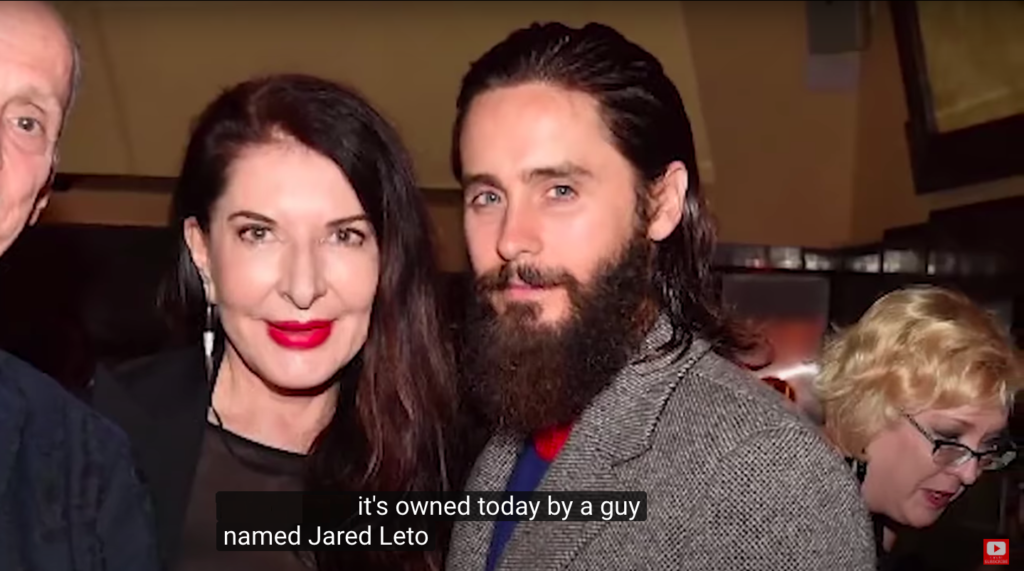
Screenshot showing Marina Abramović and Jared Leto in Out of Shadows.
Marina Abramović first makes an appearance at the 46-minute mark, shown briefly in a picture with Jared Leto as the film points to the fact that the Suicide Squad actor lives in a Laurel Canyon mansion that was once used as a military propaganda studio as evidence of contemporary Hollywood’s infernal connections. By the end of the film, though, Abramović will serve as a much bigger symbol.
Marina’s Role
Abramović first became the object of the fascination of the online right during the final days of the 2016 election, when the Wikileaks dump of emails from Clinton campaign chairman John Podesta revealed a reference to a “Spirit Cooking” dinner with the artist.
In fact, the email was from John’s brother, Tony, who had supported a Kickstarter campaign for the artist’s now-aborted Marina Abramović Institute in Hudson, New York. One of the prizes for a large donation was a “Spirit Cooking” dinner that promised “a series of traditional soups,” as well as an almond, coriander, peppercorn, and honey “Gold Ball,” a recipe that the artist had used previously to celebrate big moments in her work, like the conclusion of her MoMA show. The “Gold Ball” was something Abramović claimed to have picked up while studying Buddhism in India.
Tony Podesta was asking his brother if he would like to come to the event. John never replied. But old footage of an obscure ’90s Marina Abramović performance called “Spirit Cooking” containing pig-blood graffiti and occult slogans certainly looked spooky.
Out of Shadows rehashes all this, but also views Abramović’s role as extending far beyond evil dinner parties. Indeed, the major smoking gun it finds is the fact that Abramović tutored Lady Gaga in performance art back in 2013—thus making Gaga’s flamboyant stage shows Satanist by extension. One performance-art exercise, in which Gaga was told to enter the woods, strip, and then find her way home, is said to be suspiciously similar to CIA mind-control exercises.
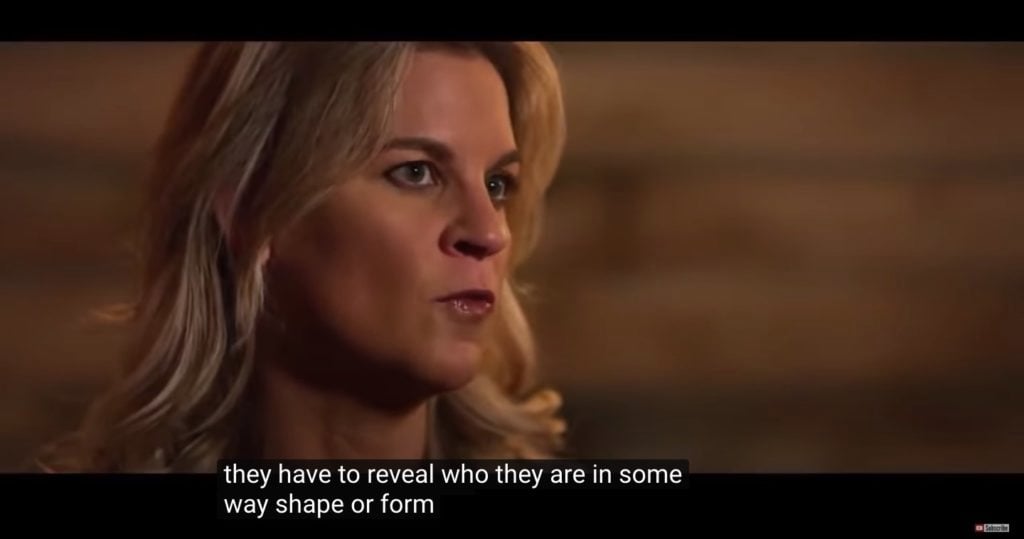
Screenshot of Liz Crokin in Out of Shadows.
“We know she is a Satanist,” erstwhile journalist Liz Crokin declares confidently of Abramović in Out of Shadows.
I asked James Westcott, who authored the 2010 biography When Marina Abramović Dies (and who previously wrote about the Podesta “Spirit Cooking” brouhaha for the MIT Press blog) how he would explain the often unsettling imagery in the artist’s work. Here’s what he wrote:
Even a cursory Google reveals the panoply of religious practices Abramović has experimented with, from Christian to Buddhist, Hindu, Australian Aboriginal. But more than that, the spirit (no pun intended) in which she does it all is pretty blatant too: the more serious she seems, actually the more playful she is being. It’s ironic that conspiracy theorists, who claim to be able to see through the surface illusions of society, take so literally and superficially one tiny component of a highly theatrical artist’s massive body of work, and don’t dig deep enough to see how un-serious it so clearly is. The interesting question is why their approach is apparently so effective: is it basically leveraging alienation and extreme social inequality? You can see why the decadent elite gatherings Abramović organizes look sinister. But it’s not because of the pretend occult baubles.
That seems about right to me: Abramović’s art draws on a lot of references from different rituals because she is looking for whatever instrument works to fascinate—but it’s generally their superficial magnetism and not their deeper systems of meaning that interest her. (For that matter, contemporary “Satanists” generally do not believe in a supernatural Devil but are just theatrical atheists trying to get a rise out of an overbearing Christian fundamentalism.)
A Grain of Truth
It’s easy for me to dwell on how outlandish Out of Shadows seems.
When Mike Smith asserts, as a way to prove the occult media conspiracy, that the word “Hollywood” is a coded reference to how ancient druids used holly branches to cast mind-control spells, and that the word “television” actually can be deciphered as the command “tell a vision,” this does not strike me as the most convincing proof to base world-shattering conclusions on.
But I think—particularly since the Artnet News audience is more likely to scoff at this stuff than take it seriously—that underscoring Westcott’s question is important: What makes the argument so effective? What gives it traction?
I don’t think Marina Abramović is a Satan-worshipper. On the other hand, I myself criticized the 2011 LA MOCA gala Abramović organized, pictured several times in Out of Shadows. Dubbed An Artist’s Life Manifesto, it saw her serve up low-paid naked women as human centerpieces for wealthy guests. Accompanying promos saw Abramović loudly declare her love of US banks and financiers as the new Medicis even as the fallout of the Great Recession was still mauling surrounding society.
Though its atmosphere was more like a rich theater kid’s Goth-themed birthday than an actual Luciferian rite, An Artist’s Life Manifesto was perfectly engineered to be a symbol of alienating decadence for anyone looking in who was actually angry about the disintegrating state of the world.
The point is that an intimation of truth animates a lot of this conspiracizing: there really is an arrogant elite that acts with impunity; the CIA really has done unconscionably horrible things; the corporate media absolutely is totally warped by money and power in ways that compromise it.
The easy impulse to dismiss Out of Shadows or its ilk as “tinfoil hat” material is actually destructive if it comes off as if it is dismissing any of these real and really felt facts.
An actually spooky moment in Out of Shadows comes when the film shows one local news anchor after another earnestly parroting the exact same script, illustrating its point of a secret pattern in the media. This glitch-in-the-matrix type moment would read as a too-on-the-nose parody of Noam Chomsky and Edward Herman’s old thesis in Manufacturing Consent if it weren’t brazenly real.
The funny thing is that what this montage actually illustrates is not the agenda of an occult elite, but the openly known right-wing corporate hold on local news. The conservative Sinclair Broadcasting Corporation is in fact infamous for the practice of mandating centrally ordered talking points that are disguised as the thoughts of trusted local voices. In this particular case, if you listen to the actual words, Sinclair’s journalists are denouncing “fake news”—a line of attack pretty much directly aimed at media foes of Donald Trump, the conspiracy-loving president!
This two-step is actually a pretty handy symbol of the role that this kind of conspiracy narrative plays, what makes it effective and what makes it dangerous: it takes the actual fear and fury about an unjust, unequal, and rigged system and channels it into chasing the shadows of a fantastic cultural cabal, which is both everywhere and never reveals itself, so its symbolism can be easily manipulated for opportunist ends.
But that means it has to be taken seriously rather than dismissed for its outlandishness. Not just because it targets artists, who are ultimately rather lacking in any real power and therefore vulnerable targets. But also because you can see how it appeals as a way to make sense of a world that really is profoundly broken, at a time when that brokenness is profoundly exposed. Any perspective that can’t account for that is itself on the way to becoming the fringe.
